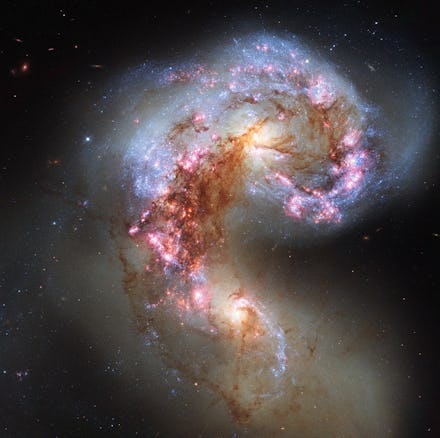These Jaw-Dropping Photos From Space Will Make You Feel Incredibly Small

How big is the known universe? Just look at this GIF:
The more we learn about outer space, the harder it becomes for astrophysicists to demonstrate the massive scale of it all. But a few incredible images can help put it all in perspective.
Space programs around the world are delivering gorgeous, mesmerizing photos from the depths of the galaxy. They reveal galaxies and stars — unfathomably large celestial bodies — at distances so far away they require a couple Excedrin to think about.
One light year — the distance light can travel in 365 days — is 5.88 trillion miles. Our own galaxy is 100,000 light years across, and the Milky Way is small as galaxies go. But the Hubble Space Telescope (which celebrated its 25th birthday last week) and the European Space Observatory's Very Large Telescope (its actual and well-deserved name) are taking us way, way beyond that.
1. The International Space Station is a little longer than a football field. Here it is compared to the moon.
From this view, the moon looks humongous. But at 14.6 million square feet in size (smaller than the continent of Asia), it's the smallest celestial body you're going to see in these photos.
2. Here are 10,000 galaxies picked up by the Hubble Space Telescope, some of which are billions of years old.
This photo took Hubble 800 exposures, 400 orbits around the Earth, and about four months to shoot.
3. The star cluster Westerlund 2, sitting 20,000 light years away, is between 1 and 2 million years old.
That's 742,422,305 Earths away.
Since a light year represents the distance light actually travels, the image actually shows what Westerlund 2 looked like 20,000 years ago.
4. The Helix, a 12,000° Celsius star, is the closest nebula to Earth — and it's 694.7 light years away, in the constellation Aquarius.
Seven hundred light years is 4,116,000,000,000,000 miles — or the United States, laid shoulder to shoulder with itself, 1,535,820,895,522 times.
It shouldn't come as a surprise that Helix's nicknames are both "Eye of God" and "Eye of Sauron." (The term "nebula" just refers to a colossal cloud of gas and dust.)
5. The Eagle Nebula's Pillars of Creation are trunks of cosmic gas 7,000 light years from Earth.
That's about 41,150,377,612,285,256 miles.
In these pillars, super-dense clouds of gas incubate brand-new stars.
6. The Sombrero Galaxy is 29 million light years from Earth. It's 30% of the size of the Milky Way Galaxy, where we live.
At the center of Sombrero sits a supermassive black hole, 1 billion times the mass of the sun. Even though it's only a third the size of the Milky Way, it has almost 10 times as many globular clusters — that is, spherical groups of what's potentially millions of stars.
Seen from the side like this, our Milky Way Galaxy looks similar: equally disk-like, but with spiraling arms.
7. We can see the region N11B, 160,000 light years from Earth, forming stars by combining hydrogen and helium.
N11B is 100 light years across — or the length of our sun laid end-to-end 6,800 times.
It's part of the Large Magellanic Cloud, another galaxy near ours. Unlike the Milky Way, however, this galaxy contains only dust clouds and stars.
8. The Horsehead Nebula, 1,500 light years from Earth, is located southwest of Orion's Belt.
Horsehead is named for its oddly equestrian figure. It contains more than a hundred different kinds of gases. It's between two and three light years across — roughly 1/50th the size of our galaxy.
9. One GIF takes us from the human body to the solar system.
Two brothers, Cary and Michael Huang, created this site in 2012 as an attempt to illustrate the relative size of humans and our world. The graphic begins with the smallest subatomic particles, and as you zoom out, the world, then the galaxy, then the entirety of outer space comes into focus.
We started the GIF with humans. Feeling small yet?